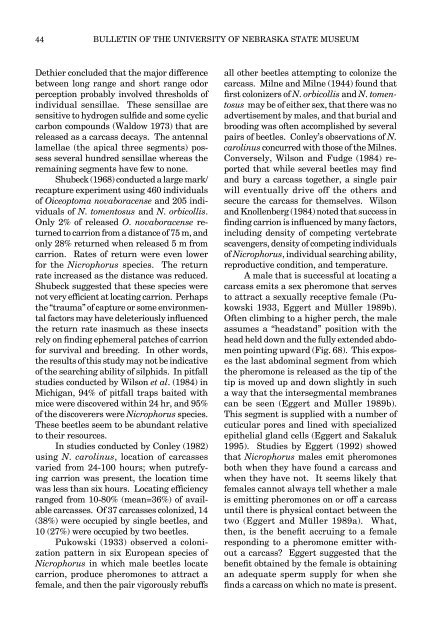Download full text - University of Nebraska State Museum
Download full text - University of Nebraska State Museum
Download full text - University of Nebraska State Museum
Create successful ePaper yourself
Turn your PDF publications into a flip-book with our unique Google optimized e-Paper software.
44<br />
BULLETIN OF THE UNIVERSITY OF NEBRASKA STATE MUSEUM<br />
Dethier concluded that the major difference<br />
between long range and short range odor<br />
perception probably involved thresholds <strong>of</strong><br />
individual sensillae. These sensillae are<br />
sensitive to hydrogen sulfide and some cyclic<br />
carbon compounds (Waldow 1973) that are<br />
released as a carcass decays. The antennal<br />
lamellae (the apical three segments) possess<br />
several hundred sensillae whereas the<br />
remaining segments have few to none.<br />
Shubeck (1968) conducted a large mark/<br />
recapture experiment using 460 individuals<br />
<strong>of</strong> Oiceoptoma novaboracense and 205 individuals<br />
<strong>of</strong> N. tomentosus and N. orbicollis.<br />
Only 2% <strong>of</strong> released O. novaboracense returned<br />
to carrion from a distance <strong>of</strong> 75 m, and<br />
only 28% returned when released 5 m from<br />
carrion. Rates <strong>of</strong> return were even lower<br />
for the Nicrophorus species. The return<br />
rate increased as the distance was reduced.<br />
Shubeck suggested that these species were<br />
not very efficient at locating carrion. Perhaps<br />
the “trauma” <strong>of</strong> capture or some environmental<br />
factors may have deleteriously influenced<br />
the return rate inasmuch as these insects<br />
rely on finding ephemeral patches <strong>of</strong> carrion<br />
for survival and breeding. In other words,<br />
the results <strong>of</strong> this study may not be indicative<br />
<strong>of</strong> the searching ability <strong>of</strong> silphids. In pitfall<br />
studies conducted by Wilson et al. (1984) in<br />
Michigan, 94% <strong>of</strong> pitfall traps baited with<br />
mice were discovered within 24 hr, and 95%<br />
<strong>of</strong> the discoverers were Nicrophorus species.<br />
These beetles seem to be abundant relative<br />
to their resources.<br />
In studies conducted by Conley (1982)<br />
using N. carolinus, location <strong>of</strong> carcasses<br />
varied from 24-100 hours; when putrefying<br />
carrion was present, the location time<br />
was less than six hours. Locating efficiency<br />
ranged from 10-80% (mean=36%) <strong>of</strong> available<br />
carcasses. Of 37 carcasses colonized, 14<br />
(38%) were occupied by single beetles, and<br />
10 (27%) were occupied by two beetles.<br />
Pukowski (1933) observed a colonization<br />
pattern in six European species <strong>of</strong><br />
Nicrophorus in which male beetles locate<br />
carrion, produce pheromones to attract a<br />
female, and then the pair vigorously rebuffs<br />
all other beetles attempting to colonize the<br />
carcass. Milne and Milne (1944) found that<br />
first colonizers <strong>of</strong> N. orbicollis and N. tomentosus<br />
may be <strong>of</strong> either sex, that there was no<br />
advertisement by males, and that burial and<br />
brooding was <strong>of</strong>ten accomplished by several<br />
pairs <strong>of</strong> beetles. Conley’s observations <strong>of</strong> N.<br />
carolinus concurred with those <strong>of</strong> the Milnes.<br />
Conversely, Wilson and Fudge (1984) reported<br />
that while several beetles may find<br />
and bury a carcass together, a single pair<br />
will eventually drive <strong>of</strong>f the others and<br />
secure the carcass for themselves. Wilson<br />
and Knollenberg (1984) noted that success in<br />
finding carrion is influenced by many factors,<br />
including density <strong>of</strong> competing vertebrate<br />
scavengers, density <strong>of</strong> competing individuals<br />
<strong>of</strong> Nicrophorus, individual searching ability,<br />
reproductive condition, and temperature.<br />
A male that is successful at locating a<br />
carcass emits a sex pheromone that serves<br />
to attract a sexually receptive female (Pukowski<br />
1933, Eggert and Müller 1989b).<br />
Often climbing to a higher perch, the male<br />
assumes a “headstand” position with the<br />
head held down and the <strong>full</strong>y extended abdomen<br />
pointing upward (Fig. 68). This exposes<br />
the last abdominal segment from which<br />
the pheromone is released as the tip <strong>of</strong> the<br />
tip is moved up and down slightly in such<br />
a way that the intersegmental membranes<br />
can be seen (Eggert and Müller 1989b).<br />
This segment is supplied with a number <strong>of</strong><br />
cuticular pores and lined with specialized<br />
epithelial gland cells (Eggert and Sakaluk<br />
1995). Studies by Eggert (1992) showed<br />
that Nicrophorus males emit pheromones<br />
both when they have found a carcass and<br />
when they have not. It seems likely that<br />
females cannot always tell whether a male<br />
is emitting pheromones on or <strong>of</strong>f a carcass<br />
until there is physical contact between the<br />
two (Eggert and Müller 1989a). What,<br />
then, is the benefit accruing to a female<br />
responding to a pheromone emitter without<br />
a carcass? Eggert suggested that the<br />
benefit obtained by the female is obtaining<br />
an adequate sperm supply for when she<br />
finds a carcass on which no mate is present.
















